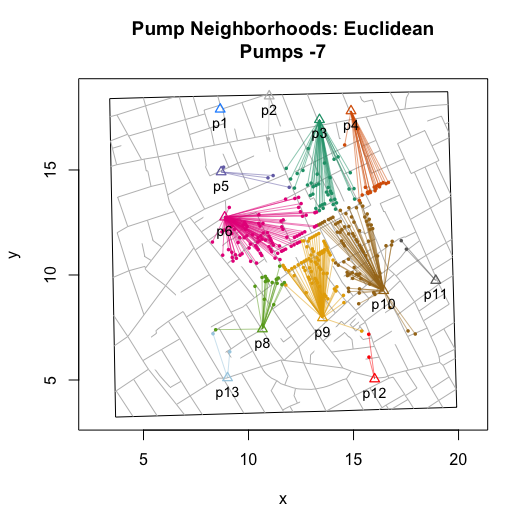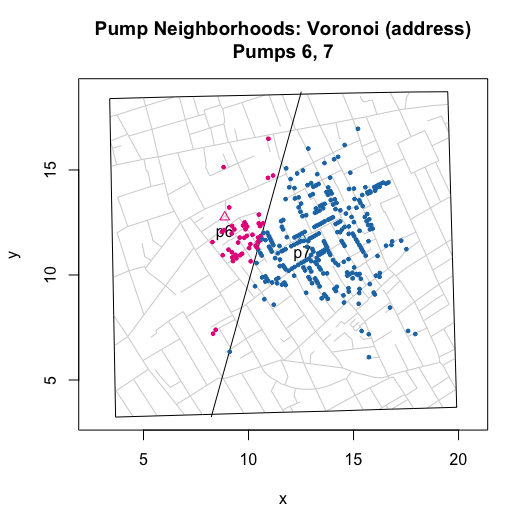- Fixes two sets of errors in Dodson and Tobler’s 1992 digitization of Snow’s map: 1) three misplaced cases/fatalities and 2) one missing road segment (part of Clifford Street).
- “Unstacks” the data in two ways to make analysis and visualization easier and more meaningful.
- Computes and visualizes “pump neighborhoods” based on Euclidean distance (Voronoi tessellation) and walking distance.
- Overlay graphical elements and features like kernel density estimates,
Voronoi diagrams, Snow’s Broad Street neighborhood, and notable
landmarks (John Snow’s residence, the Lion Brewery, etc.) via
add*()functions. - Includes a variety of functions to find and highlight cases, roads, pumps and paths.
- Appends street names to the
roadsdata set. - Includes the revised pump data used in the second version of Snow’s map from the Vestry report, which also includes the “correct” location of the Broad Street pump.
- Adds two aggregate time series fatalities data sets, taken from the Vestry report.
- Support for parallel computation on Linux, macOS and Windows.
- With ‘cholera’ version >= 0.8.0, preliminary and provisional support for georeferenced (longitude and latitude) versions of data and functions. Details below.
To install ‘cholera’ from CRAN:
install.packages("cholera")To install the current development version from GitHub:
# You may need to first install the 'remotes' via install.packages("remotes").
remotes::install_github("lindbrook/cholera", build_vignettes = TRUE)John Snow’s map, published in his On The Mode Of Communication Of Cholera, of the 1854 cholera outbreak in London is one of the best known examples of data visualization and information design:
By plotting the number and location of fatalities using stacks of bars on a map, Snow was able to perform a task that is now easily taken for granted: he visualized a spatial distribution. Looking at the results, the pattern on the map seems unmistakable. The map appears to support Snow’s claims that cholera is a waterborne disease and that the pump on Broad Street is the source of the outbreak.
And yet, despite its virtues, the map failed to convince either the authorities or Snow’s colleagues in the medical and scientific communities. Even today, many are skeptical of the map’s ability to support such claims. Beyond considerations of time and place, what critics past and present are picking up on is that a concentration of cases around the Broad Street pump alone should not be enough to convince us. The problem is the map does not refute the primary rival explanation to waterborne transmission: the pattern we see is not unlike what airborne transmission (miasma theory) might look like. In other words, while the presence of a pump at or near the epicenter of the distribution of fatalities is strong circumstantial evidence, it is nonetheless circumstantial.
This may be the reason why Snow added a graphical annotation to a second lesser-known version of the map, published in the Report On The Cholera Outbreak In The Parish Of St. James, Westminster, During The Autumn Of 1854.
Despite its hand-drawn, back-of-the-envelope appearance, Snow writes: “The inner dotted line on the map shews [sic] the various points which have been found by careful measurement to be at an equal distance by the nearest road from the pump in Broad Street and the surrounding pumps …” (Ibid., p. 109). My interpretation of this statement is that, guided by the principle that all else being equal people tend to choose the closest pump, Snow is computing a pump neighborhood: the set of addresses or locations defined by their relative proximity to a specific water pump. By doing so, Snow’s annotation sets limits on where we should and should not find fatalities. In short, Snow’s annotation is a hypothesis or prediction.
While his actual data and the specifics method of computation appear to be lost to history, I reverse engineer what I infer to be his approach by doing the following. First, from the quotation above I assume that his measure of proximity is the walking distance along the streets of Soho. Second, putting aside aside questions about the map’s accuracy (it’s actually a commercial map that Snow annotated), I consider the map to be the definitive “text” and make it the de facto source of data.
I then wrote functions that compute and visualize walking distances on the map. The value of these functions go beyond the ability to replicate and validate Snow’s efforts. By allowing you to compute hypothetical neighborhoods via selective inclusion or exclusion of pumps or to allow for different measures of proximity (e.g., Euclidean), they also allow you to explore counterfactual scenarios. Ultimately, this can help us to better assess whether we really can use the map to “prove” Snow’s claims.
While walking distanced based neighborhoods are based on paths that follow streets, Euclidean distance based neighborhoods are based on straight line paths between a location and the nearest (or selected) pump:
streetNameLocator(zoom = 1, cases = NULL, highlight = FALSE, add.subtitle = FALSE, add.title = FALSE)
title(main = "Walking Distances")
invisible(lapply(c(1, 191, 46, 363, 85), addWalkingPath))
streetNameLocator(zoom = 1, cases = NULL, highlight = FALSE, add.subtitle = FALSE, add.title = FALSE)
title(main = "Euclidean Distances")
invisible(lapply(c(1, 191, 46, 363, 85), addEuclideanPath))To build a neighborhood, we apply this algorithm to each location or “address” with at least one observed fatality. This builds the “observed” neighborhood:
plot(neighborhoodWalking())
plot(neighborhoodEuclidean())Ultimately, for testing purposes we want the “expected” neighborhoods.
For walking neighborhoods, I use the same approach but use simulated
data. Using sp::spsample() and sp::Polygon(), I place 20,000
regularly spaced points, which lie approximately 6 meters apart,
unitMeter(dist(regular.cases[1:2, ])), across the face of the map and
then compute the shortest path to the nearest pump.
plot(neighborhoodWalking(case.set = "expected"), "area.polygons")For Euclidean distance based neighborhoods, we can use the same simulated data and compute the as-the-crow-flies distance to the nearest pump. Or, we can leverage a more computationally efficient approach, Voronoi tessellation, which will produce the same neighborhoods.
plot(neighborhoodEuclidean(case.set = "expected"))
plot(neighborhoodVoronoi())To explore “observed” walking neighborhoods, use neighborhoodWalking()
with the pump.select argument:
plot(neighborhoodWalking(pump.select = 6:7))
plot(neighborhoodWalking(pump.select = -7))To explore “expected” walking neighborhoods, add the case.set = “expected” argument:
plot(neighborhoodWalking(pump.select = 6:7, case.set = "expected"), type = "area.polygons")
plot(neighborhoodWalking(pump.select = -7, case.set = "expected"), type = "area.polygons")To explore “observed” Euclidean neighborhoods, use
neighborhoodEuclidean() with the pump.select argument:
plot(neighborhoodEuclidean(pump.select = 6:7))
plot(neighborhoodEuclidean(pump.select = -7))To explore “expected” Euclidean neighborhoods, use
neighborhoodVoronoi() with the pump.select argument:
plot(neighborhoodVoronoi(pump.select = 6:7))
plot(neighborhoodVoronoi(pump.select = -7))Parallelization is implemented using the ‘parallel’ package, which is
part of the base R distribution. Where applicable, parallelization is
enabled by default via multi.core = TRUE (you can also set or limit
the number of cores by passing an integer or by setting
multi.core = FALSE. Note that although some precautions are taken in
the R application, the developers of the ‘parallel’ package strongly
discourage against using parallelization within a GUI or embedded
environment. See vignette("Parallelization") for details. That said,
I’ve had few, if any, problems with using the package in parallel on
macOS with either the R application or the
RStudio IDE.
‘cholera’ now has preliminary, limited support for georeferenced (longitude and latitude) versions of some data and functions. This support goes beyond a proof of concept but is currently less than a complete re-implementation of the package’s native (non-georeferenced) functionality. The georeferencing was done manually using QGIS; specifically its Georeferencer tool and its interface to OpenStreetMap. The target coordinate reference system (CRS) of these data is EPSG:4326. What makes this effort preliminary is that the choice of ground control points, transformation type (e.g., thin plate spine), and resampling method (e.g., nearest neighbor) are still in flux. Thus, results and coordinates may change in the future.
Six functions are available:
snowMap(latlong = TRUE)plot(walkingPath(latlong = TRUE))
plot(walkingPath()) # Dodson and Tobler native scale for comparisonplot(euclideanPath(latlong = TRUE))
plot(euclideanPath()) # Dodson and Tobler native scale for comparisonplot(neighborhoodEuclidean(latlong = TRUE))plot(neighborhoodVoronoi(latlong = TRUE))plot(neighborhoodWalking(latlong = TRUE))The vignettes are available in the package as well as online at the links below.
Duplicate and Missing Cases describes the two coding errors and the three misplaced cases that I argue are present in Dodson and Tobler’s (1992) digitization of Snow’s map.
“Unstacking” Bars discusses the inferential and visual reasons to “unstack” bars. Then, it describes the two “unstacked” data sets: one using “fatalities” and one using “addresses” as the unit of observation.
Roads
covers issues related to roads. This includes discussion of how and why
I move pump #5 from Queen Street (I) to Marlborough Mews, the overall
structure of the roads data set, “valid” road names, and my
back-of-the-envelope translation from the map’s nominal scale to meters
(and yards).
voronoiPolygons(): Tiles, Triangles and
Polygons
focuses on the voronoiPolygons() function, which extracts the vertices
of triangles (Delaunay triangulation) and tiles (Dirichelet or Voronoi
tessellation) from deldir::deldir() for use with polygon() and other
functions.
Kernel Density
Plot
discusses the the syntax of addKernelDensity(), which allows you to
define “populations” and subsets of pumps. This syntax is used in many
of the functions in ‘cholera’.
Time Series discusses functions and data related to the aggregate time series fatalities data and the questions surrounding the effect of the removal of the handle from the Broad Street pump.
Parallelization discusses the parallelization of selected functions and provides benchmark timings.
The lab notes, which are only available online, go into detail about certain issues and topics discussed in the vignettes:
note on duplicate and missing cases documents the specifics of how I fixed the two apparent coding errors and three apparently misplaced cases in Dodson and Tobler’s data.
Clifford Street missing segment discusses the missing segment at the far Eastern end of Clifford Street in Dodson and Tobler’s (1992) digitization of Snow’s map.
computing street addresses discusses how I use orthogonal projection and hierarchical cluster analysis to “unstack” bars and compute a stack’s “address”.
Euclidean v. Voronoi
neighborhoods
discusses why there are separate functions, neighborhoodEuclidean()
and neighborhoodVoronoi(), for Euclidean distance based neighborhoods.
points v. polygons discusses the tradeoff between using points() and polygon() to plot “expected” neighborhood using area plots and the computation of polygon vertices.
computing Voronoi diagrams with geographic data describes the problems and a working solution for computing Voronoi diagrams with data that use latitude and longitude.
references is an informal list of articles and books about cholera, John Snow and the 1854 outbreak.

























